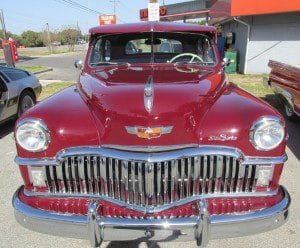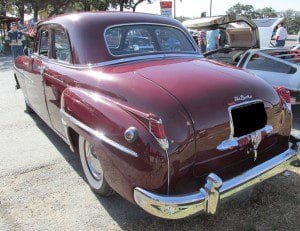The automobile featured in this article is a beautifully restored 1949 DeSoto Custom Coupe. This was the car promoted with the saying “Designed with you in mind“. DeSoto was advertised as giving you modern designing without compromising safety and comfort. Even back to 1946 most American automakers stressed reliability in their advertising as opposed to performance. Performance would come a bit later.

Between 1946 and 1954 DeSoto had three different model cycles. These were 1946-1948, 1949 -1952, 1953-1954. The first post war DeSotos were manufactured beginning in late 1945.
The first post war DeSotos as well as all the Chrysler brands differed from their competition by building valve in block engines as opposed to the overhead valve design. Within a year or two they reverted back to the overhead valve models. The 1946 Dodge models were actually a reissue of their 1942 cars and this was typical of almost all automakers at the time.
Enter the New DeSoto S-13 Models
In the middle of the 1949 production year DeSoto introduced their S-13 models. These replaced the S-11’s which had lasted from 1946 through the first part of the 1949 production cycle.All of these DeSotos, from 1946 to early 1949 looked essentially similar. The S-13’s were a major change and really were post war milestone automobiles. The years 1948 and 1949 were periods of major design change for many marquees.

Along with the new S-13’s came design changes as well. The mid range positioned DeSoto S-13 had a longer wheelbase than the S-11. Design changes included less overhang on the both the front and rear. This made the overall outside length less but the interior compartment actually offer more space.
This 1949 DeSoto Custom Coupe has the classic DeSoto vertical grille with the front and rear bumpers of a wrap around design. You might consider the overall design to have a boxy appearance.
The DeSoto is thought by many to be good car for restoration. Parts, especially mechanical, appear to be easily available since these Chrysler engines were used on a variety of vehicles including boats up to about 1972. Trim parts can be a bit difficult to locate but there are several companies specializing in vintage Chrysler products parts.

1949 DeSoto Specifications
The 1949 DeSoto Custom came with a 236 cubic inch inline six cylinder flat head engine. This was the same engine put in previous DeSoto models except with the addtiion of a new cylinder head horsepower was increased.
Chrysler Corporation had gained a fine reputation for engineering and they even advertised the fact as early as 1944 that their engines powered Sherman tanks. It’s interesting to note that Chrysler kept their brand names in front of the public during the war even though they, like everyone else, had no new cars to sell to the public.
Transmission on the 1949 DeSoto S-11 was a three speed manual Hydra-fluid. This transmission had a hydraulic coupling in place of the flywheel. Also available as an option was the Tip-Toe Shift transmission.
On the DeSoto S-13 models the DeSoto Tip-Toe Shift (other brands used other names) was standard equipment. This was billed as a semi-automatic transmission but in reality there was really no such thing as a semi-automatic in the true sense. Some might however disagree with that. To operate the transmission the driver would shift between the two forward gears, high and low, by lifting his/her foot off the accelerator at a certain speed causing the overdrive to kick in. A sound would be heard when the overdrive engaged. There were actually four speeds with this transmission. Low, low overdrive, high, and high overdrive.

The car had a wheelbase of 125.5 inches and an overall outside length of 206.75 inches. Width was 73.25 inches and height came in at 65.75 inches.
1949 was a good year for DeSoto. Total DeSoto production for 1949 was 92,400 vehicles (S-13’s) in the U.S. and 2,792 units in Canada. The Canadian S-13’s were all DeSoto Custom Club Coupes.
The DeSoto engine serial number on this model is stamped on the engine block on the left side above the generator and below the cylinder head. The body serial number should be placed on the left front door post.
DeSoto automobiles, named after the Spanish explorer Hernando de Soto, were manufactured from 1928 to 1960. Over this multi-decade span over two million DeSoto vehicles were built. The decision to cease DeSoto production was similar to what happens when a large automaker such as Chrysler has offerings that are too similar in size and price. In addition, DeSoto sales suffered quite a bit during 1958 and 1959.
Another contributing factor to DeSoto’s demise recognized by many is that each of Chrysler divisions during the 50’s were free to target markets which meant some were targeting the same market. It would only be a matter of time before one marquee would suffer at the hands of another Chrysler division.
See the AutoMuseumOnline articles on the links below…
1948 Pontiac Silver Streak Convertible
1947 Ford Super Deluxe Convertible
1949 Cadillac New Post War Design

DeSoto Collector Cars
Essentially all DeSoto automobiles are good collector cars and the marquee has a strong following represented by the National DeSoto Club. DeSoto stands as a symbol of the American automobile industry at it’s height.
The most popular DeSoto for collectors might be the 1941 and the abbreviated 1942 models. These would be in addition to the Airflow models of the mid 1930’s.
Asking prices for 1949 and 1950 DeSotos will have a lot to do with degree of restoration if any. As of this date you’ll find partially restored models being offered in the mid to high teens. Fully restored DeSotos of this period will average in the area of $40,000 with some prices being asked for museum quality condition vehicles approaching $60,000 and $70,000 and even more.
(Article and photos copyright 2014 AutoMuseumOnline)